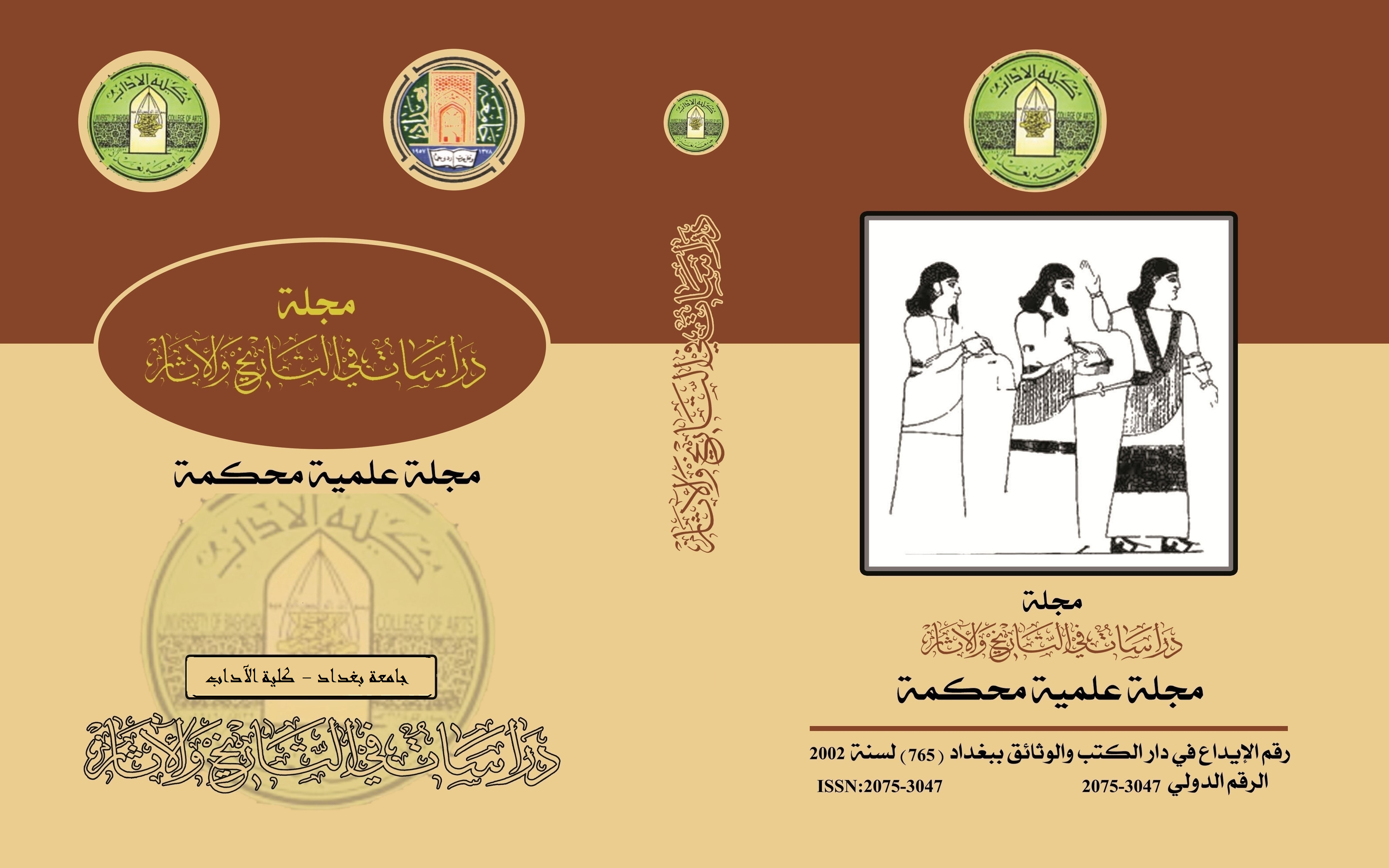تقديس الكلب في معتقدات الشرق الادنى القديم (بلاد الرافدين و وادي النيل أنموذجا)
الكلمات المفتاحية:
بلاد الرافدين، بلاد وادي النيل، التقديسالملخص
تتمتع الكلاب في حضارتي بلاد الرافدين و وادي النيل بنوع من التقديس وصل حد التأليه نتيجة لأهمية هذا الحيوان في حياة الناس خاصة في عمليات الصيد والرعي التي كان دور الكلب فيها محوريا اذ شكل وجوده مع بني البشر منذ العصور المبكرة عاملا مساعدا في تلك العمليات لغرض الحصول على الطعام ،ثم تطورت أهمية الكلب في كلا الحضارتين و ظهر له نشاط ومهام أخرى في ساحة الفكر الاعتقادي أذ أدخل في الممارسات السحرية ذات الطابع الديني للتطبيب و الشفاء من الامراض النفسية التي تسببها بعض الشياطين ،رغم تشبيه بعض الشياطين التي تسبب الشر للانسان بهذا الحيوان، كما كان له دور في ارشاد الموتى الى العالم الاسفل ،و حماية أجسادهم بتدخله بعمليات التحنيط عند المصريين أذ عد الها للتحنيط و الها حاميا للمقابر.
المراجع
- أستندرف، ديانة قدماء المصريين، ترجمة سليم حسن، القاهرة ،2000
- أسمان، يان ،الموت و العالم الاخر في مصر القديمة، ترجمة محمود محمد قاسم،القاهرة ،2011
- تشرني،ياروسلاف،الديانة المصرية القديمة،ترجمة أحمد قدوري،القاهرة،1996
- دانيال،كلين ،علم الاثار ،الجزء الثاني،ترجمة ليون يوسف،بغداد ،1990
- العميسي، فضل محمد،التجسيدات الحيوانية على الاثار في جنوب الجزيرة العربية و اليمن قبل الاسلام،الرياض،2013
- النجم، حسين يوسف،أقتصاد القرى الزراعية خلال العصرين الحديث و المعدني في العراق،أطروحة دكتوراة غير منشورة، جامعة الموصل،كليةالاداب،2006
- نجيب ،خضرأحمد، الاثر الجليل لقدماء وادي النيل ،القاهرة،1991
- هورنونج،أريك ،وادي الملوك،أفق الابدية ،العالم الاخر لدى قدماء المصريين، ترجمة محمد العزب، القاهرة،1996
- هورنونج،اريك،ديانة مصر الفرعونية الوحدانية و التعدد،ترجمة محمود ماهر و مصطفى ابو الخير،القاهرة ،1995
-هرو،برت ام،كتاب الموتى الفرعوني،ترجمة، والس بدج،القاهرة ،1988
- يوركر،مانفرد،معجم المعبودات و الرموز في حضارة مصر القديمة،ترجمة صلاح رمضان، القاهرة،2000
المصادر الاجنبية
(1) Arlene C, and Noreen L, An Atlas of Interpretative Radiographic Anatomy of the Dog and Cat, London, 2002
Albert,M.,Ancient civilization prehistory,London,2000)
(3) Brock,J.C.,Early History Domestical Animals Westren Asia,sumer,Vol.36,1980
(4) Budge,E,A.,Legends of Egyptian,Gods,London,1912
(5) Clbert, A., The Flora and Founa of the Ancient Near East in Civilization of the Ancient Near East, New York, 2000
(6)Daniel A. Foxvog, Elementary Sumerian Glossary, California, 2009
(7) Hayes,W.C.,the Scepter of Egypt,part II,London,1978
The Routledge Dictionary of Egyptian Gods and Goddesses,London,2005 Har,t,G,(8)
(9) Michelle, J., Determining the Antiquity of Dog Origins: London, 2004
(10)Taylor,J.,Death and the After life in Ancient Egypt,British,2001,p.244,246
(11)Wiggermann, F. A.,Black Dogs in Mesopotamia and Beyond,Germany,2017
(12)Wiggermann, F. A. Dogs, Pigs, Lamaštu, and the Breast-Feeding of Animals by Women. ,Boston, 2010.
التنزيلات
منشور
إصدار
القسم
الرخصة

هذا العمل مرخص بموجب Creative Commons Attribution 4.0 International License.
:حقوق الطبع والنشر والترخيص
بالنسبة لجميع البحوث المنشورة في مجلة دراسات في التاريخ والآثار، يحتفظ الباحثون بحقوق النشر. يتم ترخيص البحوث بموجب ترخيص Creative Commons CC BY 4.0 المفتوح ، مما يعني أنه يجوز لأي شخص تنزيل البحث وقراءته مجانًا. بالإضافة إلى ذلك ، يجوز إعادة استخدام البحث واقتباسه شريطة أن يتم الاستشهاد المصدر المنشور الأصلي. تتيح هذه الشروط الاستخدام الأقصى لعمل الباحث وعرضه.
:إعادة إنتاج البحوث المنشورة من الناشرين الآخرين
من الضروري للغاية أن يحصل الباحثون على إذن لإعادة إنتاج أي بحث منشورة (أشكال أو مخططات أو جداول أو أي مقتطفات من نص) لا يدخل في نطاق الملكية العامة أو لا يملكون حقوق نشرها. يجب أن يطلب الباحثون إذنًا من مؤلف حقوق النشر (عادة ما يكون الناشر).
يطلب الإذن في الحالات التالية:
بحوثك الخاصة المنشورة من قِبل ناشرين آخرين ولم تحتفظ بحقوق النشر الخاصة بها.
مقتطفات كبيرة من بحوث أي شخص أو سلسلة من البحوث المنشورة.
استخدم الجداول والرسوم البيانية والمخططات والمخططات والأعمال الفنية إذا لم يتم التعديل عليها.
الصور الفوتوغرافية التي لا تملك حقوق لنشرها.
لا يطلب الإذن في الحالات التالية:
إعادة بناء الجدول الخاص بك مع البيانات المنشورة بالفعل في مكان آخر. يرجى ملاحظة أنه في هذه الحالة يجب عليك ذكر مصدر البيانات في شكل "بيانات من ..." أو "مقتبس من ...".
تعتبر عروض الأسعار القصيرة معقولة الاستخدام العادل ، وبالتالي لا تتطلب إذنًا.
الرسوم البيانية ، الرسوم البيانية ، المخططات ، الأعمال الفنية التي أعاد الباحث رسمها بالكامل والتي تم تغييرها بشكل ملحوظ إلى درجة لا تتطلب الاعتراف.
الحصول على إذن
لتجنب التأخير غير الضروري في عملية النشر ، يجب أن تبدأ في الحصول على أذونات في أقرب وقت ممكن. لا يمكن لمجلة الآداب نشر بحث مقتبس من منشورات أخرى دون إذن.
قد يمنحك مالك حقوق الطبع والنشر تعليمات بشأن شكل الإقرار الواجب اتباعه لتوثيق عمله ؛ بخلاف ذلك ، اتبع النمط: "مستنسخ بإذن من [المؤلف] ، [كتاب / المجلة] ؛ نشره [الناشر] ، [السنة]." في نهاية شرح الجدول ، الشكل أو المخطط.



















